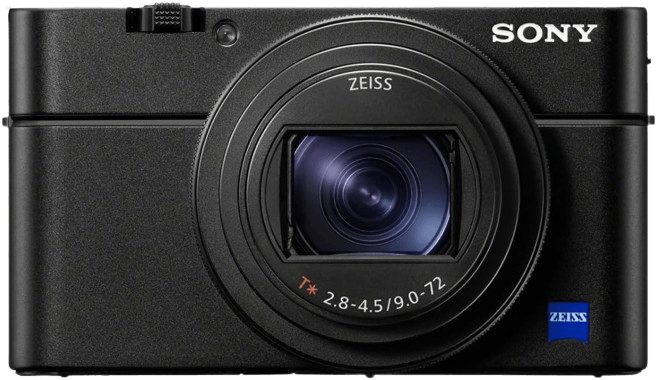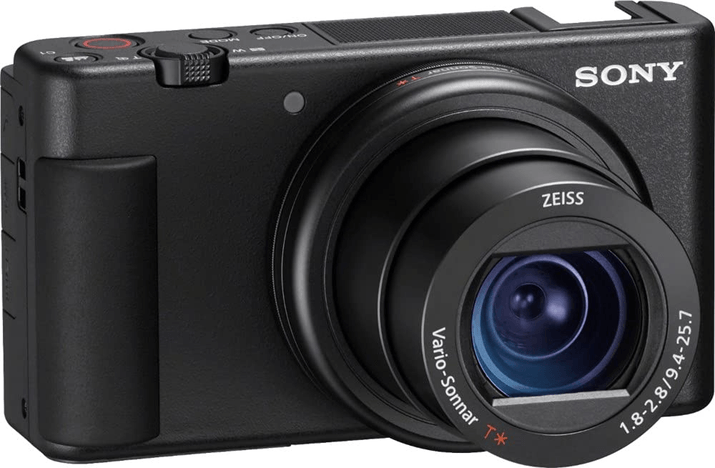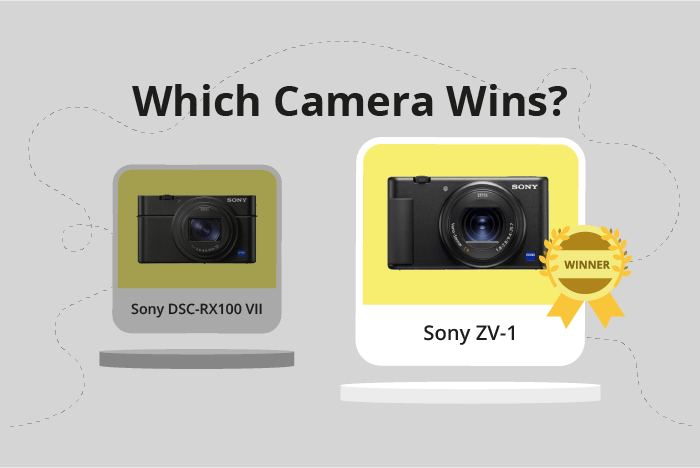Sony Cyber-shot DSC-RX100 VII vs ZV-1 Comparison
Sony RX100 VII

Sony ZV-1

The Sony ZV-1 takes the lead with a score of 65/100, while the Sony Cyber-shot DSC-RX100 VII trails behind at 60/100. Both cameras share the compact category, with the Sony ZV-1 measuring 105 x 60 x 44mm and weighing 294g, while the Sony RX100 VII measures 102 x 58 x 43mm and weighs 302g.
The Sony ZV-1 has the advantage of a lower launch price of $800 compared to the Sony RX100 VII’s $1200. This makes the ZV-1 a more budget-friendly option. Additionally, the ZV-1 is slightly lighter, making it a more portable choice.
On the other hand, the Sony RX100 VII, released in 2019, has a marginally smaller body, providing a more compact design. However, this difference is minimal and may not significantly impact users’ preferences.
Taking all factors into account, the Sony ZV-1 emerges as the better camera due to its higher score, lower price, and lighter weight. The Sony RX100 VII’s slightly smaller size may not be enough to sway users’ decisions.
Sony Cyber-shot DSC-RX100 VII vs ZV-1 Overview and Optics
The Sony ZV-1 wins in optics with a score of 67/100, while the Sony Cyber-shot DSC-RX100 VII scores 61/100. Both cameras share several specifications, including 20 megapixels, CMOS sensor type, Bionz X processor, 1″ sensor size, fixed lens mount, and image stabilization.
The ZV-1 outperforms the RX100 VII in two significant aspects. First, it has a superior shooting speed of 24, compared to the RX100 VII’s 5. This faster shooting speed enables the ZV-1 to capture more images in a shorter time, especially useful for action photography. Second, the ZV-1 has a higher DXOMARK score for its sensor at 82, while the RX100 VII has a score of 63. This higher score means the ZV-1’s sensor provides better image quality and low-light performance.
On the other hand, the RX100 VII does not have any specific optical advantage over the ZV-1. Both cameras share the same megapixels, sensor type, and image stabilization features. However, the RX100 VII still delivers good image quality and performance, making it a suitable choice for many users.
Based on the comparison, the Sony ZV-1 is the better option in terms of optics, offering faster shooting speed and a higher quality sensor. The RX100 VII, though not surpassing the ZV-1 in any particular area, still provides decent optical performance. Ultimately, the choice between these two cameras depends on the user’s specific needs and preferences.
Sony Cyber-shot DSC-RX100 VII vs ZV-1 Video Performance
The Sony Cyber-shot DSC-RX100 VII and the Sony ZV-1 both received a video score of 91 out of 100, which means there is no clear winner in terms of video capabilities. Both cameras offer 4K video resolution with maximum dimensions of 3840 x 2160 and a maximum video frame rate of 120fps. Additionally, they both have built-in time-lapse functionality.
The winning camera in this comparison is subjective due to their identical scores and specifications. However, one may argue that the Sony Cyber-shot DSC-RX100 VII is superior due to its compact size, making it more portable and convenient for on-the-go video shooting.
On the other hand, the Sony ZV-1 may be considered better for some users because it is designed specifically for vlogging and content creation. This may result in better ergonomics, more accessible controls, and additional features that cater to the needs of vloggers and content creators.
In terms of video capabilities, both the Sony Cyber-shot DSC-RX100 VII and the Sony ZV-1 are on equal footing, offering impressive performance and features. The choice between these two cameras mainly depends on the user’s specific needs and preferences. If portability is a priority, the DSC-RX100 VII may be the better option, while the ZV-1 may be more suitable for those focused on vlogging and content creation.
Sony Cyber-shot DSC-RX100 VII vs ZV-1 Features and Benefits
The Sony Cyber-shot DSC-RX100 VII and the Sony ZV-1 are evenly matched in terms of features, with both cameras scoring 68/100. Both cameras share several common specifications, such as a 3-inch touchscreen with similar resolutions (921,000 dots for the RX100 VII and 921,600 dots for the ZV-1), a flip screen, and no GPS. Additionally, both cameras have WiFi and Bluetooth capabilities.
The RX100 VII stands out in certain aspects, despite the identical feature scores. One notable advantage is the higher resolution of its screen, albeit by a small margin. This difference results in a more detailed and crisper image when reviewing photos and videos on the camera.
The ZV-1, on the other hand, also has its advantages. Its slightly better screen resolution provides a marginally improved user experience when using the touchscreen. This can make tasks such as adjusting settings or reviewing footage slightly smoother.
Both the RX100 VII and the ZV-1 are strong contenders in their respective categories, and their feature scores reflect this. The RX100 VII’s slightly higher screen resolution provides a small advantage in image quality. In contrast, the ZV-1’s marginally better touchscreen resolution offers a slightly improved user experience.
In the end, the choice between these two cameras comes down to personal preference and specific needs. While they share many features, the RX100 VII and the ZV-1 each have their unique advantages that may appeal to different users.
Sony Cyber-shot DSC-RX100 VII vs ZV-1 Storage and Battery
The Sony Cyber-shot DSC-RX100 VII and the Sony ZV-1 have identical storage and battery scores of 29/100. Both cameras share common specifications, including one memory card slot, accepting SD/SDHC/SDXC and Memory Stick Pro Duo cards. They also have the same battery life of 260 shots, powered by an NP-BX1 battery, and offer USB charging capabilities.
Although the storage and battery scores are equal, the Sony ZV-1 has a slight advantage in memory card compatibility, as it also accepts Memory Stick Pro-HG Duo cards. This additional compatibility provides users with more flexibility in choosing their preferred storage media.
The Sony Cyber-shot DSC-RX100 VII, on the other hand, does not have any distinct advantages in the storage and battery category, as both cameras share most specifications.
Given the similarities in storage and battery features, potential buyers should focus on other aspects of these cameras to make their decision. While the Sony ZV-1 has a minor advantage in memory card compatibility, it is not a significant factor that could sway the decision between these two cameras.
Sony Cyber-shot DSC-RX100 VII vs ZV-1 – Our Verdict
Are you still undecided about which camera is right for you? Have a look at these popular comparisons that feature the Sony Cyber-shot DSC-RX100 VII or the Sony ZV-1:

